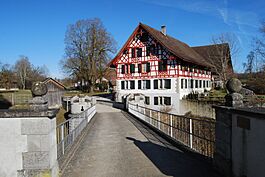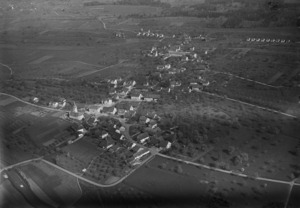Wigoltingen facts for kids
Quick facts for kids
Wigoltingen
|
||
|---|---|---|

Altenklingen
|
||
|
||
| Country | Switzerland | |
| Canton | Thurgau | |
| District | Weinfelden | |
| Area | ||
| • Total | 17.13 km2 (6.61 sq mi) | |
| Elevation | 431 m (1,414 ft) | |
| Population
(Dec 2020 )
|
||
| • Total | 2,558 | |
| • Density | 149.33/km2 (386.76/sq mi) | |
| Postal code |
8556
|
|
| Surrounded by | Amlikon-Bissegg, Homburg, Hüttlingen, Kemmental, Märstetten, Müllheim, Raperswilen, Wäldi | |
Wigoltingen is a small town, also called a municipality, located in the Weinfelden district. It is part of the canton of Thurgau in Switzerland. It's a place with a mix of farms, forests, and homes.
Contents
About Wigoltingen's Land
Wigoltingen covers an area of about 17.15 square kilometers (6.62 square miles). A large part of this land, about 75.4%, is used for farming. This means there are many fields for growing crops.
About 12.5% of the area is covered by forests. These are important for nature and provide green spaces. The rest of the land is used for buildings, roads, rivers, and lakes.
Most of the built-up areas are parks, green spaces, and sports fields. The forests are mostly dense woods, with some areas having fruit trees. The agricultural land is mainly for growing crops. Rivers and streams make up most of the water in the municipality.
In 1995, two smaller areas, Engwang and Illhart, joined with Wigoltingen. This made the municipality larger.
Who Lives in Wigoltingen?
Wigoltingen has a population of about 2,126 people. A small part of the population, around 10.6%, are people from other countries.
Most people in Wigoltingen speak German, which is about 94.4% of the population. Other languages spoken include Italian (1.8%) and Portuguese (1.4%).
Population Changes Over Time
Over the last ten years, the number of people living in Wigoltingen has changed slightly. In 2008, there were more deaths than births among Swiss citizens. However, the number of people from other countries stayed about the same or increased slightly. Overall, the population decreased a little in 2008.
Age Groups in Wigoltingen
The population of Wigoltingen includes people of all ages.
- About 9.2% are children aged 0 to 9 years old.
- Around 13.3% are teenagers aged 10 to 19.
- Adults aged 20 to 59 make up a large part of the population, about 57.8%.
- Older adults, aged 60 and above, make up about 19.8% of the population.
Homes and Families
In 2000, there were 752 homes in Wigoltingen, with about 2.7 people living in each home on average. Most of the buildings were single-family homes. Many people lived as couples with children.
How People Vote
In the 2007 national election, the most popular political party in Wigoltingen was the SVP. They received about 42.64% of the votes. Other popular parties included the FDP and the CVP. About half of the people who could vote actually did vote in that election.
Wigoltingen's Population History
Here is how the population of Wigoltingen has changed over the years:
| year | population |
|---|---|
| 1950 | 1,694 |
| 1960 | 1,741 |
| 1980 | 1,645 |
| 1990 | 1,868 |
| 2000 | 2,036 |
Important Historical Places
Altenklingen Castle is a very important historical site in Switzerland. It is listed as a national heritage site, meaning it is protected because of its historical value. The small village of Engwang and Altenklingen Castle are both recognized as important Swiss heritage sites.
Gallery
How People Work in Wigoltingen
In 2007, the unemployment rate in Wigoltingen was low, at 1.43%. This means most people who wanted to work had jobs.
People in Wigoltingen work in different types of jobs:
- Primary sector: This includes jobs like farming and forestry. About 202 people work in this area.
- Secondary sector: These are jobs in manufacturing and construction. About 365 people work in this sector.
- Tertiary sector: This includes jobs in services, like shops, offices, and healthcare. About 257 people work here.
Many people who live in Wigoltingen travel to other towns for work. Also, some people from other towns come to Wigoltingen to work. Most people use a private car to get to work, while a smaller number use public transportation.
Religions in Wigoltingen
Based on a census from 2000, many people in Wigoltingen belong to different religious groups.
- About 24.9% of the population are Roman Catholic.
- About 58.4% belong to the Swiss Reformed Church (a Protestant church).
- Smaller numbers of people belong to other Christian churches, the Orthodox Church, or are Islamic.
- Some people do not belong to any church or did not answer the question.
Learning and Schools
Education is important in Wigoltingen. About 74.4% of adults have completed high school or gone on to higher education, like university.
Wigoltingen has its own school district for primary and secondary education. In the 2008/2009 school year, there were 343 students in total.
- Kindergarten: There were 61 children in kindergarten.
- Primary School: There were 100 children in the lower primary grades and 115 in the upper primary grades.
- Secondary School: Students are grouped based on their performance. There were 64 teenagers in the advanced school and 64 in the standard school.
The schools aim to provide a good education for all students.
Getting Around
The Müllheim-Wigoltingen railway station is an important stop for trains. It is served by the Zürich S-Bahn services S8 and S30. This makes it easy for people to travel to and from Wigoltingen by train.
See also
 In Spanish: Wigoltingen para niños
In Spanish: Wigoltingen para niños







